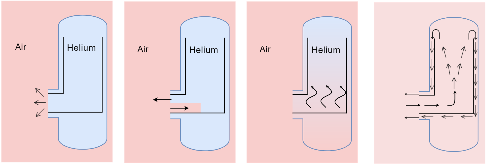Numerical study of air ingress transition to natural circulation in a high temperature helium loop
Abstract
Here, the generation-IV high temperature gas cooled reactors (HTGRs) are designed with many passive safety features, one of which is the ability to passively remove heat under a loss of coolant accident (LOCA). However, several common reactor designs do not prevent against a large break in the coolant system and may therefore experience a depressurized LOCA. This would lead to air entering into the reactor system via several potential modes of ingress: diffusion, gravity currents, and natural circulation. At the onset of a LOCA, the initial rate of air ingress is expected to be very slow because it is governed by molecular diffusion. However, after several hours, natural circulation would commence, thus, bringing the air into the reactor system at a much higher rate. As a consequence, air ingress would cause the high temperature graphite matrix to oxidize, leading to its thermal degradation and decreased passive heat (decay) removal capability. Therefore, it is essential to understand the transition of air ingress from molecular diffusion to natural circulation in an HTGR system. This paper presents results from a computational fluid dynamics (CFD) model to study the air ingress transition behavior. These results are validated against an h-shaped high temperature helium loopmore »
- Authors:
-
- Kansas State Univ., Manhattan, KS (United States)
- Oak Ridge National Lab. (ORNL), Oak Ridge, TN (United States)
- Publication Date:
- Research Org.:
- Oak Ridge National Laboratory (ORNL), Oak Ridge, TN (United States)
- Sponsoring Org.:
- USDOE Office of Nuclear Energy (NE)
- OSTI Identifier:
- 1437917
- Alternate Identifier(s):
- OSTI ID: 1549305
- Grant/Contract Number:
- AC05-00OR22725; NE0008412
- Resource Type:
- Accepted Manuscript
- Journal Name:
- Annals of Nuclear Energy (Oxford)
- Additional Journal Information:
- Journal Name: Annals of Nuclear Energy (Oxford); Journal Volume: 111; Journal Issue: C; Journal ID: ISSN 0306-4549
- Publisher:
- Elsevier
- Country of Publication:
- United States
- Language:
- English
- Subject:
- 42 ENGINEERING; HTGRs; Air ingress; Diffusion; Natural circulation
Citation Formats
Franken, Daniel, Gould, Daniel, Jain, Prashant K., and Bindra, Hitesh. Numerical study of air ingress transition to natural circulation in a high temperature helium loop. United States: N. p., 2017.
Web. doi:10.1016/j.anucene.2017.09.007.
Franken, Daniel, Gould, Daniel, Jain, Prashant K., & Bindra, Hitesh. Numerical study of air ingress transition to natural circulation in a high temperature helium loop. United States. https://doi.org/10.1016/j.anucene.2017.09.007
Franken, Daniel, Gould, Daniel, Jain, Prashant K., and Bindra, Hitesh. Thu .
"Numerical study of air ingress transition to natural circulation in a high temperature helium loop". United States. https://doi.org/10.1016/j.anucene.2017.09.007. https://www.osti.gov/servlets/purl/1437917.
@article{osti_1437917,
title = {Numerical study of air ingress transition to natural circulation in a high temperature helium loop},
author = {Franken, Daniel and Gould, Daniel and Jain, Prashant K. and Bindra, Hitesh},
abstractNote = {Here, the generation-IV high temperature gas cooled reactors (HTGRs) are designed with many passive safety features, one of which is the ability to passively remove heat under a loss of coolant accident (LOCA). However, several common reactor designs do not prevent against a large break in the coolant system and may therefore experience a depressurized LOCA. This would lead to air entering into the reactor system via several potential modes of ingress: diffusion, gravity currents, and natural circulation. At the onset of a LOCA, the initial rate of air ingress is expected to be very slow because it is governed by molecular diffusion. However, after several hours, natural circulation would commence, thus, bringing the air into the reactor system at a much higher rate. As a consequence, air ingress would cause the high temperature graphite matrix to oxidize, leading to its thermal degradation and decreased passive heat (decay) removal capability. Therefore, it is essential to understand the transition of air ingress from molecular diffusion to natural circulation in an HTGR system. This paper presents results from a computational fluid dynamics (CFD) model to study the air ingress transition behavior. These results are validated against an h-shaped high temperature helium loop experiment. Details are provided to quantitatively predict the transition time from molecular diffusion to natural circulation.},
doi = {10.1016/j.anucene.2017.09.007},
journal = {Annals of Nuclear Energy (Oxford)},
number = C,
volume = 111,
place = {United States},
year = {Thu Sep 21 00:00:00 EDT 2017},
month = {Thu Sep 21 00:00:00 EDT 2017}
}
Web of Science
Figures / Tables:
 Figure 1: Stages of flow in a LOCA scenario [1]
Figure 1: Stages of flow in a LOCA scenario [1]

 Search WorldCat to find libraries that may hold this journal
Search WorldCat to find libraries that may hold this journal